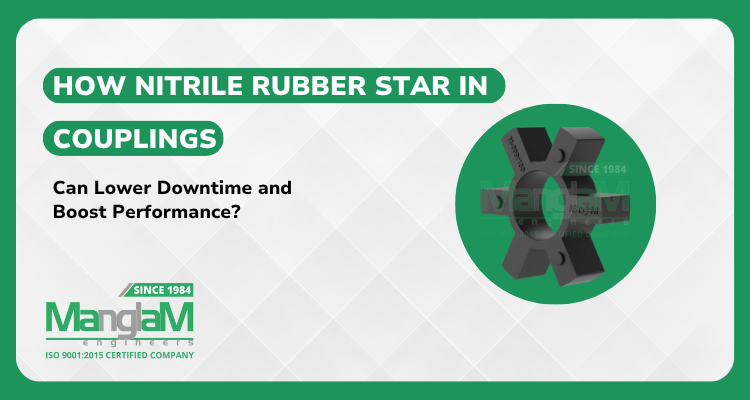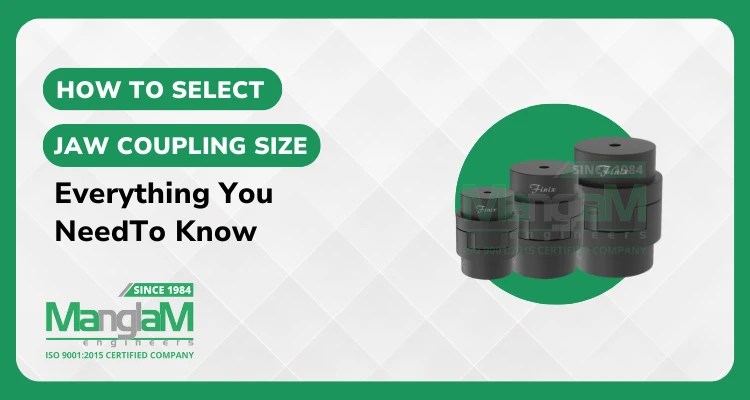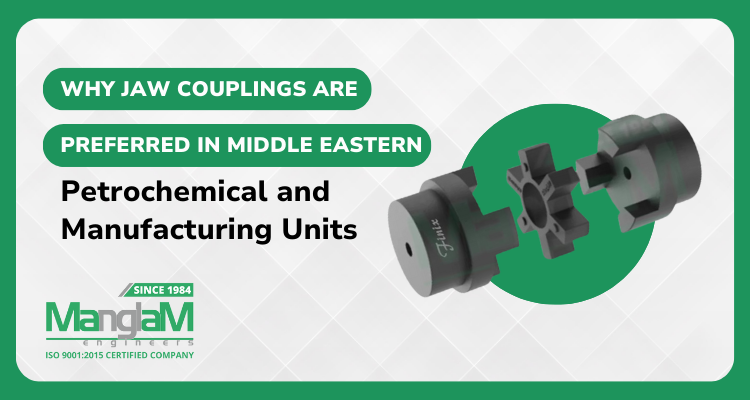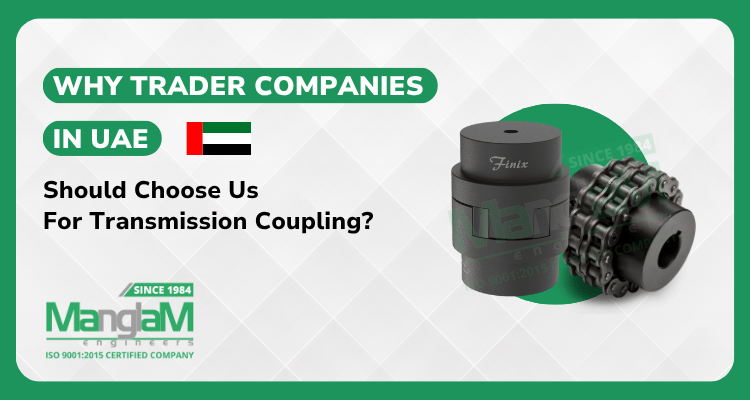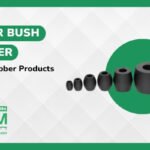
Rubber Bush Supplier: Best-In Rubber Products
May 9, 2025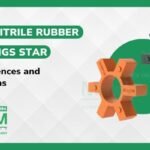
PU vs. Nitrile Rubber Coupling Star: Key Differences and Applications
June 11, 2025How Nitrile Rubber Star Couplings Can Lower Downtime and Boost Performance
In today’s fast-paced industrial environments, even a few minutes of machinery downtime can lead to significant losses. That’s why choosing the right coupling isn't just a maintenance decision—it’s a smart business move.
Nitrile rubber star couplings are rapidly becoming the preferred choice for engineers and maintenance heads across sectors like manufacturing, oil & gas, and power generation. Why? Because they strike the perfect balance between flexibility, durability, and cost-efficiency.
In this blog, we’ll break down what makes nitrile star couplings different, how they reduce vibration and wear, and why they’re essential for modern machinery running at full capacity—whether you're operating in India, Dubai, South Africa, Europe, or anywhere across the globe.
What is a Nitrile Rubber Star Coupling?
A nitrile rubber star coupling is a flexible mechanical coupling that uses a star-shaped elastomeric insert to connect two rotating shafts while accommodating misalignment and dampening vibrations. The coupling consists of two metal hubs connected through a nitrile rubber spider or star insert, creating a reliable power transmission system with built-in shock absorption.
Key Components and Design
The nitrile rubber spider coupling features three primary components:
- Metal Hubs: Precision-machined steel or aluminum hubs that attach to each shaft
- Nitrile Star Insert: The flexible elastomeric element that provides coupling flexibility
- Fastening System: Bolts or clamps that secure the assembly
The star design maximizes contact area while maintaining structural integrity under high-torque applications. Each "arm" of the star distributes load evenly, preventing stress concentration that could lead to premature failure.
How It Works in Power Transmission
Industrial couplings with nitrile inserts transmit torque through compression and tension of the elastomeric element. When one hub rotates, it compresses the star insert, which then pushes against the receiving hub. This indirect power transmission allows the coupling to absorb shock loads and accommodate angular, parallel, and axial misalignments simultaneously.
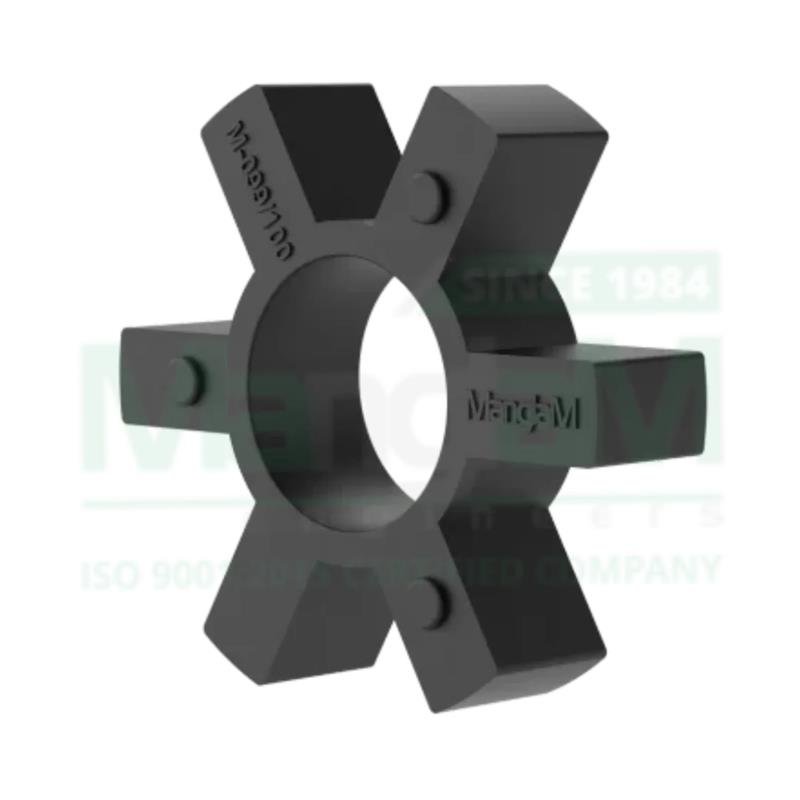

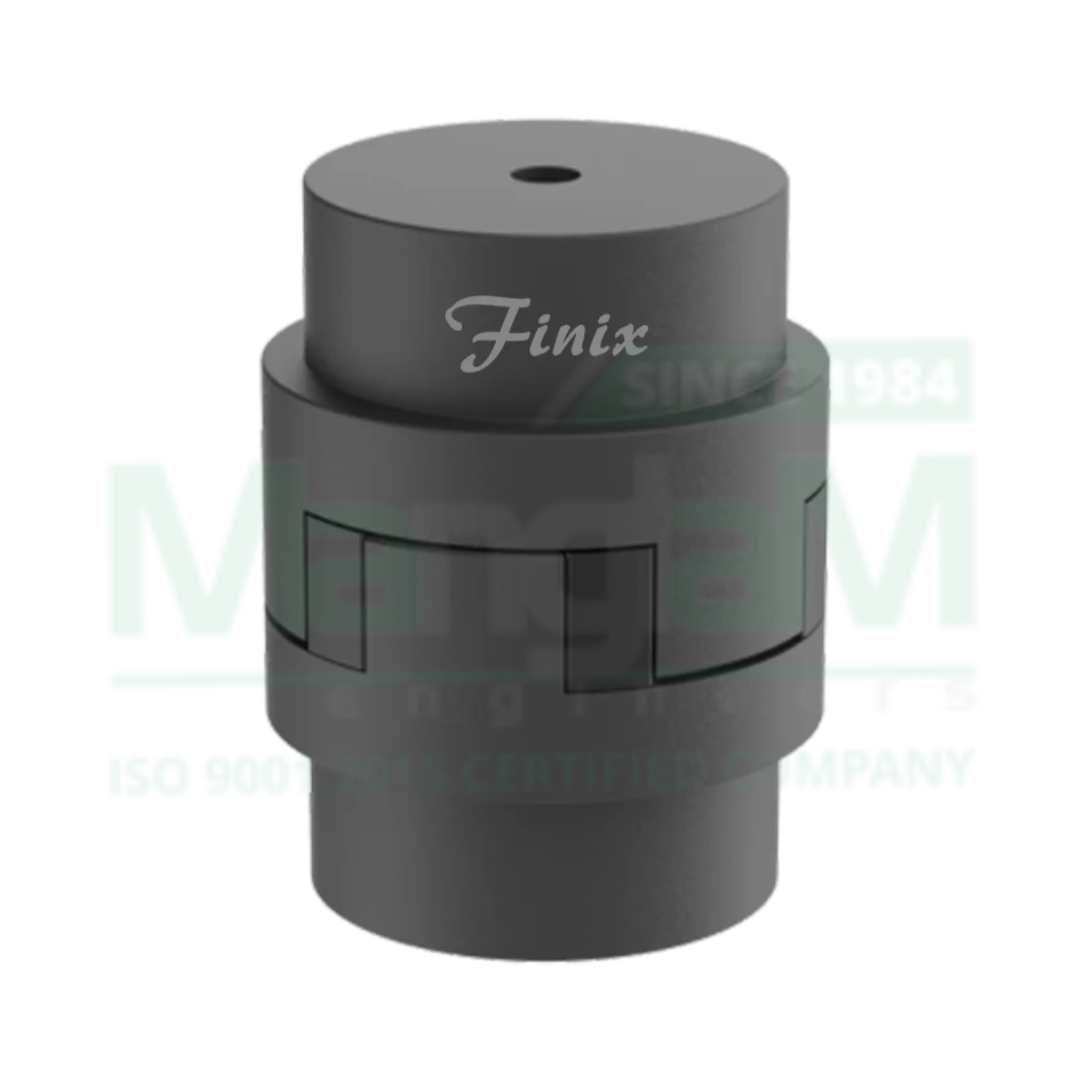

Why Choose Nitrile Rubber Over Other Materials?
Material selection significantly impacts coupling performance, longevity, and maintenance requirements. Nitrile rubber coupling insert benefits stem from its unique molecular structure that provides superior resistance to oils, fuels, and industrial chemicals while maintaining flexibility across a wide temperature range.
Nitrile vs Polyurethane Coupling Insert Comparison
The coupling insert material comparison reveals distinct advantages:
Nitrile Rubber Advantages:
- Excellent oil and fuel resistance
- Superior temperature stability (-40°F to +250°F)
- Cost-effective for most applications
- Proven track record in industrial environments
Polyurethane Advantages:
- Higher load capacity
- Better abrasion resistance
- Longer service life in dry conditions
Chemical Resistance and Temperature Range
Nitrile's synthetic rubber composition provides exceptional resistance to:
- Petroleum-based oils and lubricants
- Hydraulic fluids
- Fuel and gasoline
- Moderate acids and bases
This nitrile vs polyurethane coupling insert comparison shows that nitrile offers the best balance of performance and value for most industrial applications, particularly in oil-rich environments common in manufacturing and heavy machinery.
How Does Nitrile Rubber Star Reduce Equipment Downtime?
Equipment downtime typically results from bearing failure, shaft misalignment, and vibration-induced wear. How nitrile rubber reduces downtime involves three critical mechanisms that address these root causes directly.
Vibration Dampening Capabilities
Vibration dampening in star couplings occurs through the hysteretic properties of nitrile rubber. When subjected to cyclic loading, the elastomeric material converts mechanical energy into heat, effectively reducing vibration transmission between connected components.
Independent testing shows that nitrile spider coupling performance can reduce vibration levels by 40-60% compared to rigid couplings. This dampening effect protects downstream components including:
- Bearings and seals
- Gearboxes and transmissions
- Motor windings and rotors
- Connected equipment foundations
Shock Absorption Benefits
Sudden load changes, startup torques, and emergency stops create shock loads that can damage rigid coupling systems. Resilient couplings for shock absorption using nitrile inserts can handle instantaneous torque spikes up to 300% of rated capacity without failure.
Real-world applications demonstrate significant improvements:
- Manufacturing Plant Case Study: A textile manufacturer reduced unplanned downtime by 45% after replacing rigid couplings with nitrile star couplings on their main production line
- Pump Station Application: A water treatment facility extended pump bearing life from 18 months to 4+ years using star couplings for vibration reduction
Extended Service Life
The self-lubricating properties of nitrile rubber eliminate the need for regular greasing or oil changes required by other coupling types. Properly installed flexible couplings with rubber star inserts typically provide 3-5 years of maintenance-free operation under normal conditions.
Service life factors include:
- Operating temperature stability
- Chemical compatibility with environment
- Proper torque rating selection
- Correct installation alignment
Want to see how much your plant could save? Contact our team for a quick ROI analysis.
Top 7 Performance Benefits of Nitrile Star Couplings
Nitrile spider coupling performance delivers measurable improvements across multiple operational parameters that directly impact your bottom line.
1. Misalignment Compensation
Industrial machinery rarely maintains perfect alignment due to thermal expansion, foundation settling, and normal wear. Industrial rubber coupling parts accommodate:
- Angular misalignment: Up to 1-2 degrees
- Parallel misalignment: Up to 0.010-0.020 inches
- Axial movement: Up to 0.125 inches
This flexibility eliminates the need for costly precision alignment while preventing premature bearing wear that costs thousands in replacement parts and labor.
2. Torque Transmission Efficiency
Unlike toothed or chain couplings that introduce backlash, flexible jaw coupling components with nitrile inserts provide direct torque transmission with minimal play. Efficiency ratings consistently exceed 98% across the operating range.
3. Maintenance Cost Reduction
Coupling solutions for machinery wear using nitrile inserts reduce maintenance costs through:
- Elimination of lubrication requirements
- Extended bearing life (3-4x longer)
- Reduced vibration-related component wear
- Simplified replacement procedures
Cost Analysis Example:
- Traditional coupling annual maintenance: $2,400
- Nitrile star coupling annual maintenance: $800
- Annual savings: $1,600 per coupling
4. Zero Backlash Operation
The compression-based power transmission eliminates backlash common in mechanical couplings, providing:
- Precise positioning control
- Reduced gear train wear
- Improved system responsiveness
- Better accuracy in automated systems
5. Electrical Isolation
Nitrile rubber provides natural electrical isolation between shafts, preventing:
- Ground loop currents
- Electrical discharge machining (EDM) of bearings
- Static buildup in sensitive applications
- Electromagnetic interference transmission
6. Quick Installation and Replacement
Modular design allows field replacement without moving connected equipment. Typical replacement time: 15-30 minutes versus 2-4 hours for rigid couplings requiring realignment.
7. Temperature Stability
Consistent performance across industrial temperature ranges maintains coupling characteristics without seasonal adjustments or temperature compensation.
Which Industries Benefit Most from Nitrile Star Couplings?
Industrial rubber coupling parts find applications across diverse sectors where reliability, vibration control, and chemical resistance are critical success factors.
1. Manufacturing and Heavy Machinery
Manufacturing operations require continuous uptime to meet production schedules and maintain profitability. Improve machine uptime with rubber insert technology in:
- Conveyor Systems: Reduce belt tracking issues and bearing wear
- Pumps and Compressors: Minimize vibration transmission to piping systems
- Machine Tools: Improve surface finish quality through vibration reduction
- Material Handling: Extend component life in harsh operating environments
Indian manufacturing centers, particularly in Ahmedabad and surrounding Gujarat industrial areas, have adopted nitrile star couplings extensively due to their proven performance in high-temperature, chemically aggressive environments common in textile and chemical processing.
2. Automotive and Aerospace
Precision requirements and weight considerations make flexible couplings with rubber star inserts ideal for:
- Engine test stands
- Transmission testing equipment
- Assembly line automation
- Parts handling systems
The vibration isolation properties protect sensitive measurement equipment while maintaining accurate torque transmission for testing protocols.
3. Oil & Gas Applications
Chemical resistance and temperature stability make nitrile couplings essential for:
- Pump stations and pipeline systems
- Drilling equipment and mud pumps
- Refinery processing equipment
- Offshore platform machinery
4. Power Generation
Utility-scale power generation requires coupling systems that can handle:
- High starting torques
- Continuous duty cycles
- Extreme temperature variations
- Critical reliability requirements
Nitrile star couplings provide the necessary performance characteristics while reducing maintenance costs in coal, gas, and renewable energy applications.
Manglam Engineers supplies these critical applications throughout the Middle East, including Dubai, Kuwait, Qatar, and Jordan, where extreme temperatures and aggressive chemicals challenge conventional coupling materials.
How to Maximize Nitrile Star Coupling Performance
Proper installation and maintenance practices directly impact coupling life and system reliability. Following established procedures ensures optimal nitrile spider coupling performance throughout the service interval.
1. Proper Installation Guidelines
Step 1: Pre-Installation Inspection
- Verify coupling size and insert durometer rating
- Check shaft dimensions and keyway specifications
- Confirm environmental compatibility
- Inspect for shipping damage
Step 2: Alignment Procedures
While nitrile couplings accommodate misalignment, optimal performance requires initial alignment within specifications:
- Angular misalignment: <0.5 degrees preferred
- Parallel offset: <0.005 inches preferred
- Axial positioning: Center of allowable range
Step 3: Installation Sequence
- Install hubs on shafts with proper torque specifications
- Position equipment for proper axial spacing
- Install nitrile star insert without forcing
- Apply specified bolt torque in cross pattern
- Verify smooth rotation through full range
2. Maintenance Schedule Recommendations
Monthly Inspections:
- Visual check for insert cracking or wear
- Listen for unusual noise or vibration
- Verify proper axial positioning
- Check fastener tightness
Quarterly Assessments:
- Measure vibration levels
- Check alignment drift
- Document operating temperatures
- Inspect for chemical degradation
Annual Overhauls:
- Remove and inspect insert condition
- Replace if hardness changes >10 Shore A points
- Check hub wear patterns
- Update maintenance records
3. Signs of Wear and Replacement Indicators
Immediate Replacement Required:
- Visible cracks in star arms
- Missing or damaged insert sections
- Excessive hardness (durometer increase >15 points)
- Oil swelling or chemical attack
Planned Replacement Indicators:
- Increased vibration levels
- Gradual hardness changes
- Surface checking or oxidation
- Reaching recommended service interval
Improve uptime by scheduling rubber insert replacements during planned maintenance, instead of waiting for unexpected failures.
Troubleshooting Nitrile Star Coupling Issues
Common coupling problems often result from installation errors, environmental factors, or operating conditions exceeding design specifications. Understanding these issues enables proactive solutions.
Premature Wear Solutions
Problem: Insert wear occurring before expected service life Root Causes:
- Excessive misalignment beyond coupling capacity
- Operating temperatures exceeding material limits
- Chemical incompatibility with process fluids
- Overloading beyond torque ratings
Solutions:
- Improve equipment alignment procedures
- Select higher temperature rating materials
- Evaluate chemical resistance requirements
- Verify actual operating torques
Vibration Problems
Problem: Star coupling for vibration reduction not meeting expectations Analysis Required:
- Baseline vibration measurements
- Frequency analysis of dominant vibrations
- Coupling natural frequency calculations
- System resonance evaluation
Corrective Actions:
- Adjust insert durometer for optimal dampening
- Modify coupling size for frequency tuning
- Add supplementary dampening if required
- Address upstream vibration sources
Temperature-Related Issues
Problem: Coupling performance degradation in high-temperature applications Contributing Factors:
- Ambient temperature variations
- Heat generation from misalignment
- Process heat transfer through shafts
- Inadequate ventilation around coupling
Temperature Management:
- Install heat shields if necessary
- Improve coupling area ventilation
- Consider higher temperature insert materials
- Monitor actual operating temperatures
How to Select the Perfect Nitrile Star Coupling for Your Application
Proper coupling selection ensures optimal performance, maximum service life, and lowest total cost of ownership. Flexible jaw coupling components must be matched to specific application requirements.
Load and Torque Requirements
Torque Calculation Process:
- Determine normal operating torque
- Calculate maximum starting torque
- Apply service factor (typically 1.5-3.0)
- Select coupling with adequate capacity
Service Factor Guidelines:
- Continuous duty, smooth loads: 1.5
- Intermittent duty, moderate shock: 2.0
- Heavy shock loads, frequent starts: 3.0
Can nitrile rubber couplings handle high torque applications? Yes, when properly sized. Available torque ranges extend from fractional horsepower to over 10,000 lb-ft for industrial applications.
Environmental Considerations
Chemical Compatibility Assessment:
- Identify all process chemicals
- Evaluate temperature exposure ranges
- Consider cleaning agents and solvents
- Account for potential chemical mixing
Environmental Factors:
- Operating temperature extremes
- Humidity and moisture exposure
- UV radiation in outdoor installations
- Abrasive particulates in atmosphere
Size and Compatibility Factors
Dimensional Requirements:
- Shaft diameters and tolerances
- Available axial space
- Radial clearance limitations
- Weight restrictions
Interface Specifications:
- Keyway standards (metric vs. imperial)
- Hub mounting configurations
- Fastener specifications
- Balancing requirements for high-speed applications
Professional Selection Support: Manglam Engineers provides application engineering support to ensure optimal coupling selection. Our technical team evaluates your specific requirements and recommends the most cost-effective solution based on 40+ years of industry experience.
Conclusion and Next Steps
Nitrile rubber star couplings represent a proven solution for reducing equipment downtime while boosting industrial performance. The combination of superior vibration dampening, shock absorption, and chemical resistance directly addresses the root causes of machinery failure and maintenance costs.
Key Takeaways:
- Measurable downtime reduction: 40-60% fewer unplanned outages
- Significant cost savings: 50-70% lower maintenance expenses
- Extended equipment life: 3-4x longer bearing and component service intervals
- Improved reliability: Fewer emergency repairs and production interruptions
- Chemical resistance: Excellent performance in oil-rich industrial environments
Your Next Actions:
- Audit current coupling systems to identify improvement opportunities
- Calculate potential savings based on your downtime and maintenance costs
- Consult with coupling experts to ensure proper application engineering
- Implement pilot programs in critical applications to demonstrate benefits
- Develop replacement schedules for systematic coupling upgrades
Why Partner with Manglam Engineers?
With over 40 years of manufacturing experience, Manglam Engineers supplies durable, high-quality rubber star couplings designed for a wide range of industrial applications.
We’ve supported businesses across India, Dubai, South Africa, Europe, Kuwait, Jordan, Qatar, and other regions worldwide—helping them improve equipment reliability, reduce maintenance costs, and meet tough performance demands. From product selection to ongoing support, we ensure every coupling delivers measurable value.
📞 Let’s Discuss Your Requirements
Call us: +91 78744 79699
Email us: manglamengineers22@gmail.com
Website: manglamengineers.com
Our engineering team is ready to analyze your machinery and recommend the ideal coupling solution. Don’t let coupling failures disrupt your production—partner with us for proven, cost-effective upgrades.
Experience the difference that 40+ years of coupling expertise makes in your industrial operations.

